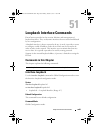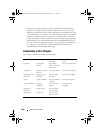
Multicast Commands 1067
52
Multicast Commands
The PowerConnect Multicast component is best suited for video and audio
traffic requiring multicast packet control for optimal operation. The
Multicast component includes support for IGMPv2, IGMPv3, PIM-DM,
PIM-SM, and DVMRP. Communication from point to multipoint is called
Multicasting. The source host (point) transmits a message to a group of zero
or more hosts (multipoint) that are identified by a single IP destination
address. Although the task may be accomplished by sending unicast (point-
to-point) messages to each of the destination hosts, multicasting is the more
desirable method for this type of transmission. A multicast message is
delivered to all members of its destination host group with the same best-
efforts reliability as regular unicast IP messages. The message is not
guaranteed to arrive intact at all members of the destination group or in the
same order relative to other messages. The advantages of multicasting are
explained below:
• Network Load Decrease: A number of applications are required to transmit
packets to hundreds of stations. The packets transmitted to these stations
share a group of links on their paths to their destinations. Multicast
transmission can conserve much needed network bandwidth, since
multicasting transmission requires the transmission of only a single packet
by the source and replicates this packet only if it is necessary (at forks of
the multicast delivery tree).
• Discovery of resources: A number of applications require a host to find out
whether a certain type of service is available. Internet protocols such as
Bootstrap Protocol (BOOTP) and Open Shortest Path First (OSPF)
protocol are among these applications. Using multicast messages and
sending the query to those hosts which are potentially capable of providing
this service speeds the gathering of this information considerably.
Although a group of hosts residing on the same network are the intended
target for the majority of multicast packets, this limitation is not
mandatory. Discovering the local domain-name server is the intended use
of multicast messages on remote networks when there is less than one
server per network.
2CSPC4.XCT-SWUM2XX1.book Page 1067 Monday, October 3, 2011 11:05 AM


















